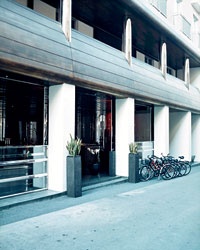 David Cicconi The Duomo Hotel in Rimini, Italy
Much hyped and long delayed, Ron Arad’s first hotel opens in Rimini. Valerie Waterhouse spends the night to see if it lives up to all the buzz
David Cicconi The Duomo Hotel in Rimini, Italy
Much hyped and long delayed, Ron Arad’s first hotel opens in Rimini. Valerie Waterhouse spends the night to see if it lives up to all the buzz
Arad’s vision begins with the façade. Burnished bronze cladding winds its way inside to become the ceiling of the ground-floor bar, then rolls down the rear wall to form a curvaceous bench. Red lacquer doors resembling pinball-machine flippers lead to the futuristic reception area. Included in your stay: use of a bicycle and free admission to a beach 10 minutes away.
Eyebrows were raised when London-based designer Ron Arad, known for his sinuous metal furniture, announced plans for a hotel in the Italian seaside resort of Rimini, 62 miles east of Bologna. The Adriatic coastal town is no design city, and many considered it a strange location for Arad, who had just created a floor at Madrid’s Hotel Puerta América. But hotel-watchers were intrigued by initial sketches of the front desk, a spaceship-like tilted metal ring. The Duomo finally opened in June, more than a year late, and it’s clear that Arad didn’t hold himself back—witness The Desk, dramatically realized in polished steel and rumored to have cost upward of $220,000. "I do not want to make people feel at home, because they’re not at home," Arad says of his hotel—and in this he has succeeded. But in the end, the 34 rooms and nine suites are perhaps too iconoclastic, tending to sacrifice function for form. 28 Via G. Bruno; 39-0541/24215; www.duomohotel.com; doubles from $275.
The standard (Urban) rooms are 270 square feet and sparsely furnished, with double or twin beds, a small desk, an even smaller bedside table, and a flat-screen TV. They are arranged over four floors by color (magenta, lime green, purple, and red). Circular openings in the wall behind the bed look into the pod-shaped bathrooms, which have glass-front walls (a Venetian blind in the window allows for privacy). Beds are surprisingly comfortable, outfitted with silk throws by Bologna-based designer Chiara Castelli. This is one of the few local touches; there are almost no other references to the area’s rich traditions.
The room’s desk is a narrow, wave-shaped shelf designed by Arad. It’s functional and pleasing to use, but its position—beneath a large flat-screen TV—makes (minor) head injuries almost inevitable. The petal-shaped Ripple chair in hard thermoplastic (by Arad for Moroso) is far more comfortable and ergonomic than it appears.
The flexible steel, LED lamps with convenient bedside switches allow you to read without disturbing your partner; unfortunately, the tiny, notepad-sized shelf that serves as a bedside table barely holds a glass of water, never mind a book. In fact, the room’s only storage space is a five-foot-wide transparent glass wardrobe (not for the untidy) wedged into the bedroom side of the see-through bathroom wall.
The Urban room’s centerpiece is its white Corian-clad bathroom—fittingly described as a wet-room pod. Water from the curtainless shower sprays directly onto the teak-slatted bathroom floor, which doubles as a drainage board; the Alessi white-porcelain fittings, like the toilet and bidet, also get drenched. The hotel’s room stylists (known in less cutting-edge establishments as housekeeping) mop the bathrooms several times a day. The custom-made toiletries in the hotel’s signature lime green, purple, and red schemes add a colorful (and drier) splash to the otherwise monochromatic space.
The hotel’s design is most successful in the lobby bar, NoMi, where guests and locals mingle over tapas-style dishes (kiwi, tomato, and pecorino dip; ravioli with fresh seafood). A giant, amoeba-shaped bar in bronze and mirrored steel anchors the space; the bronze bench formed by the curving wall is flanked by Arad’s metal Kompass tables and cream Ripple chairs. The space anticipates the Duomo’s inevitable popularity, especially in the summer months: the side wall is a sliding glass door that will allow revelers to spill out into the street.